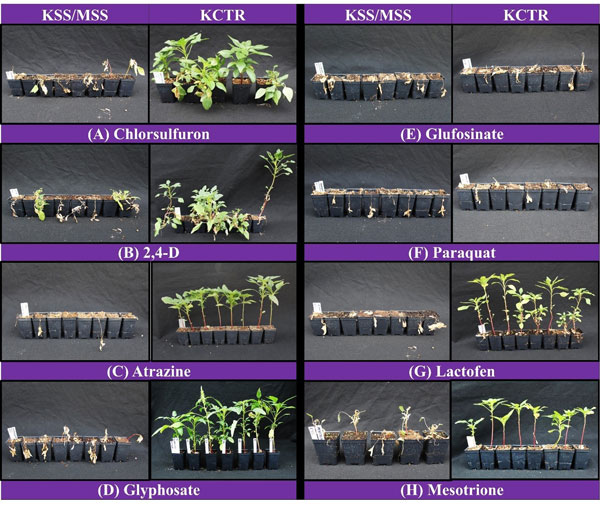A six-way herbicide-resistant Palmer amaranth population was the subject of a study recently published by K-State weed scientists. The Palmer amaranth population was collected from a 45-year old tillage study maintained in continuous sorghum. A variety of herbicides were used in the research trial, with 2,4-D and atrazine used most frequently. However, when plants from this population were studied in the greenhouse, they survived applications of group 2 herbicides Glean (chlorsulfuron), Harmony (thifensulfuron), Beyond (imazamox), Pursuit (imazethapyr); group 14 herbicides Cobra (lactofen) and Flexstar (fomesafen); the group 27 herbicides Callisto (mesotrione) and Laudis (tembotrione), metribuzin (group 5); and glyphosate (group 9); as well as atrazine (group 5) and 2,4-D (group 4). The only herbicides in the study that provided 100% control were Liberty (glufosinate) and Gramoxone (paraquat; Figure 1).

Figure 1. Susceptible (KSS/MSS) and resistant Palmer amaranth 2-4 weeks after treatment with the listed herbicides.
One of the key findings of this research is that metabolism-based resistance (MBR; Table 2) was found for five of the six sites of action. A weed with MBR converts the herbicides to inactive forms before the plant can be killed, often due to the activity of two groups of enzymes: cytochrome P450s and glutathione S-transfersases. These enzymes provide selectivity to many of the herbicides used in crops.
Table 2. Resistance mechanisms in a Kansas Palmer amaranth population (Shyam et al., 2021).
|
Herbicide group |
Resistance type1 |
Suspected mechanism |
|
2 |
MBR |
Cytochrome P450 |
|
4 |
MBR |
Cytochrome P450 |
|
5 |
MBR |
Glutathione GST |
|
9 |
TSBR |
Gene amplification |
|
14 |
MBR |
Cytochrome P450 |
|
27 |
MBR |
Cytochrome P450 |
|
1MBR = Metabolism-based resistance; TSBR = Target site-based resistance |
||
Prior to about 2013, target site-based resistance (TSBR) was the most common mechanism identified in research and much of our thinking was based on these reports. As more is learned about MBR, it is forcing us to rethink many of our assumptions regarding herbicide resistance development. This research clearly demonstrates the greatest threat associated with MBR is that a single resistance mechanism can provide resistance to multiple herbicide groups. While mixing and rotating herbicides with multiple effective sites of action can slow the evolution of resistance, cross-resistance associated with MBR greatly reduces the effectiveness of this strategy. Minimizing the weed seed bank and adopting alternative management strategies is essential to protect the value of existing and future herbicides.
Reference: Shyam, C., E.A. Borgato, D.E. Peterson, J.A. Dille and M. Jugulam. 2021. Predominance of metabolic resistance in a six-way resistant Palmer amaranth population. Frontiers in Plant Science 11:1-12.
Sarah Lancaster, Weed Management Specialist
lancaster@ksu.edu
Mithila Jugulam, Research Weed Scientist
mithila@ksu.edu
Bob Hartzler, Weed Management Specialist – Iowa State University
hartzler@iastate.edu